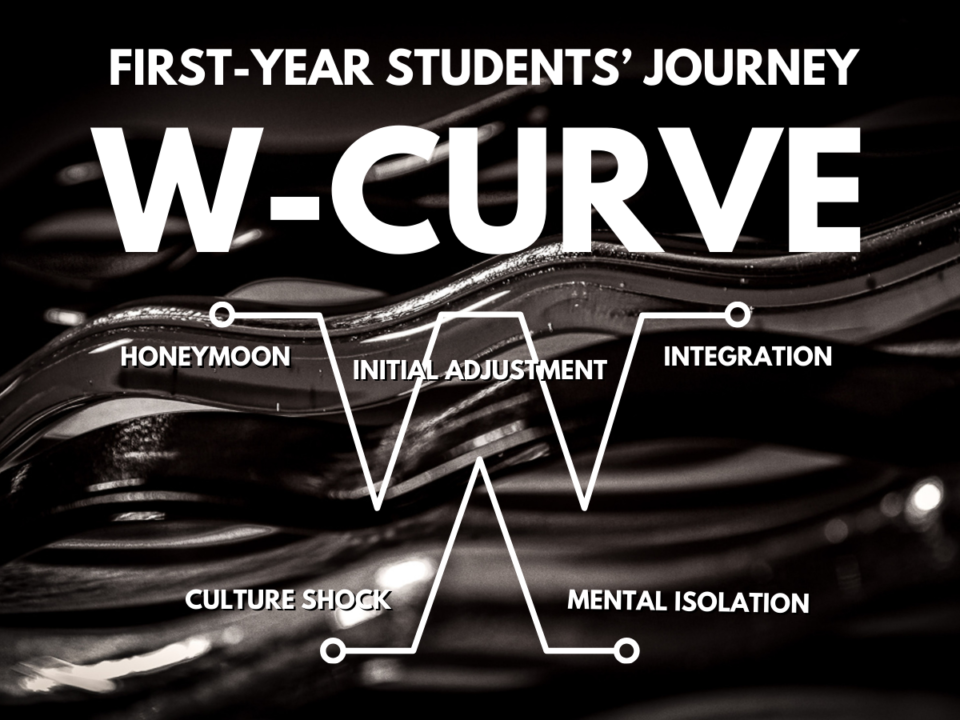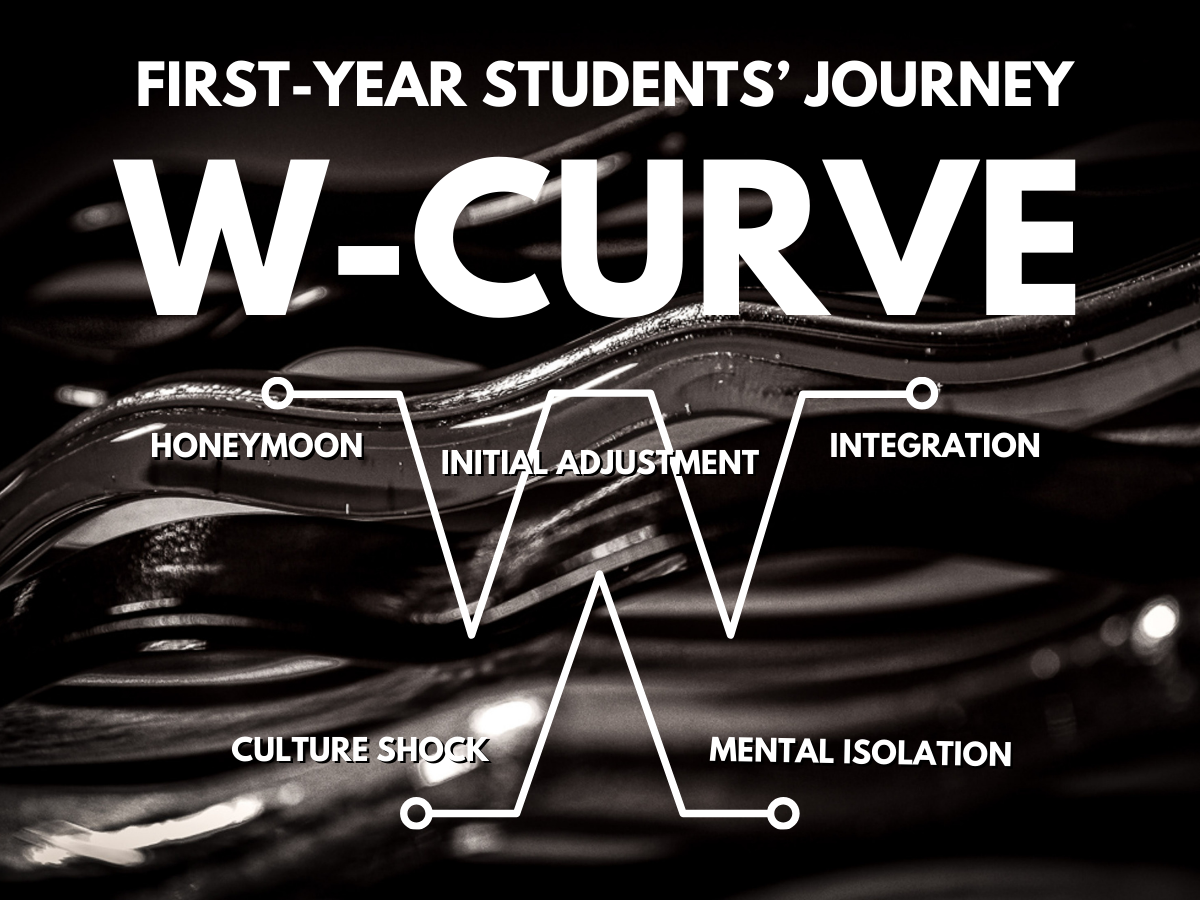
Starting college brings new expectations for academic success, campus involvement and managing life on your own, a challenging transition that can be defined by the W-Curve.
The original idea for the W-Curve is made up of five stages: honeymoon, culture shock, initial adjustment, mental isolation, and acceptance and integration. The idea arose when students studying abroad realized it created culture shock and caused homesickness.
In 1993, William J. Zeller and Robert Moiser in their “Culture Shock and The First-Year Experience” report found that the W-Curve could also be applied to first-year college students as they navigate through their first semester of college.
St. Thomas faculty member Patricia Maddox teaches the W-Curve to first-year college students in her First-Year Experience class. Maddox describes the W-Curve as it pertains to students at St. Thomas.
“If you look at the curve, the beginning of the honeymoon phase actually starts before college,” Maddox said. “You’re on those apps getting to know your roommates, you’re buying all this cool stuff for your rooms, you’re getting excited about your student schedule, everything sounds awesome.”
First-year students start the semester high with all the newfound freedom of college life, meeting new friends, learning in new classes and joining campus activities, said Maddox.
“We usually start the semester at the top as an institution supporting you to show you all the cool things St. Thomas has to offer,” Maddox said.
On-campus activities, clubs and events are in place to help first-year students feel more at home and feel less alone as they navigate their new college along with their new friends.
The St. Thomas activities fair and club meetings are just a couple events St. Thomas holds for first-year students to boost involvement and allow students to connect with one another.
After the height of the W-Curve, it slowly starts to dip and students begin to recognize the hardships of being on their own in college.
Weeks six through eight are the bottom of the W-Curve, which, for St. Thomas, are around fall midterms.
“We start to see at the bottom of that initial culture shock where all the newness has kind of worn away,” Maddox said. “You start to feel like I don’t belong. You want to go home and you might go home, which makes it sometimes worse.”
Post-fall break is when the curve shifts upward a little bit, creating a neutral environment for students, according to the W-Curve study. Seeing friends and family over fall break is a good reset for students and then they are ready to be back on campus, Maddox said.
Weeks 10 through 12 are the second bottom of the curve, which Maddox called “mental isolation.”
Students are more likely to isolate themselves in their rooms at this point of the semester and are having motivation issues and class attendance issues, Maddox said.
“You’ve passed midterms and grades might not be where they’re at, which adds stress,” Maddox said.
The institution helps students during this time by bringing in support animals around campus, breakfast for dinner events, and other activities to lift students’ spirits and bring some motivation to finish off the semester.
The semester then finishes at the final point of the W-Curve where students have successfully finished college finals for the first time and have a long break to relax and regroup.
“I think there are things that students can do to support themselves and there are things that the institution can do to support students,” Maddox said.
Pico Volko, a first-year student at St. Thomas said that for them, the point of stress came toward the end of the first semester.
“That was a very difficult time because it was kind of at that point in the semester where things were getting very difficult and on top of that, I was really worried about what classes I was taking next semester,” Volkov said. “I think just the combination of keeping up with what I need to do while trying to look forward was very overwhelming for me.”
Maddox said that one of the most important things to do is for students to not go home within the first fall semester of college, at least until break. Staying on campus during those first couple of months without going home can be very beneficial to students to gain a sense of routine and stability at college before returning home to the routine they are used to.
“Not going home, staying on campus, looking at your resources, using your resources, building those connections with friends, getting out of your comfort zone,” Maddox said are all ways to help students adjust to campus life.
Going home was a different experience for Volkov compared to the students the W-Curve described.
“I don’t really feel like (going home) affected my transition to college because I really value my independence and was glad to have my independence finally. So going home felt more like a way to ensure that,” Volkov said.
The W-Curve is meant to demonstrate first-year students’ experience without a global pandemic happening, so now with COVID-19, there is a new lens to the W-Curve. Maddox expressed her sympathy for students entering college during the pandemic because she acknowledged it is a lot more difficult to build connections and stay involved when classes are on Zoom, in-person events are canceled and there are restrictions on numbers of people in certain areas.
“I get so many requests right now from students asking to take classes on Zoom,
Maddox said. “It’s great to stay in our rooms, but that only contributes to the mental isolation piece.”
There is new pressure on professors to figure out how to best support college students nowadays, because this isn’t a typical college experience, said Maddox.
However, colleges like St. Thomas offer great resources to help first-year students transition to the college experience.
The W-Curve is a visual depiction of how first-year college students go through their first semester, especially now with the pandemic. It can help professors understand how students are feeling, as well as helping parents understand and even first-year students understand what challenges they might experience.
Macy Berendsen can be reached at macy.berendsen@stthomas.edu.



